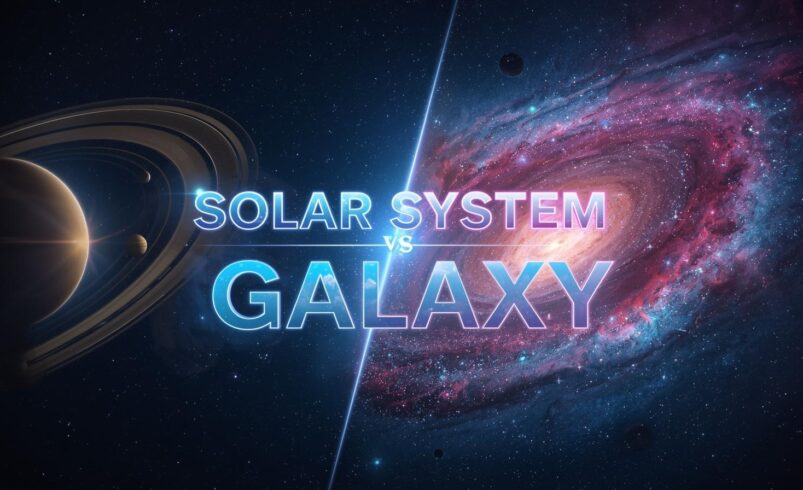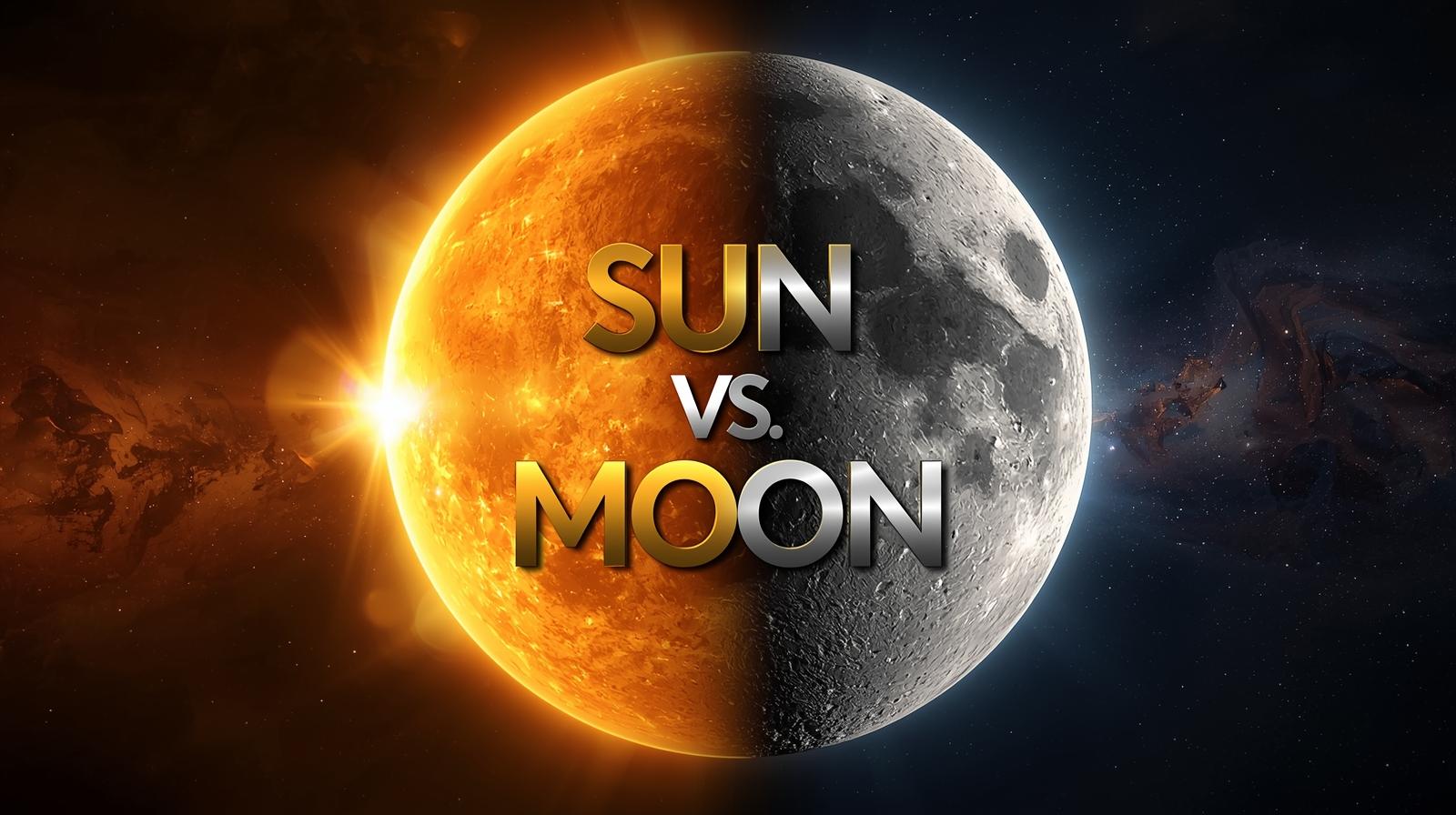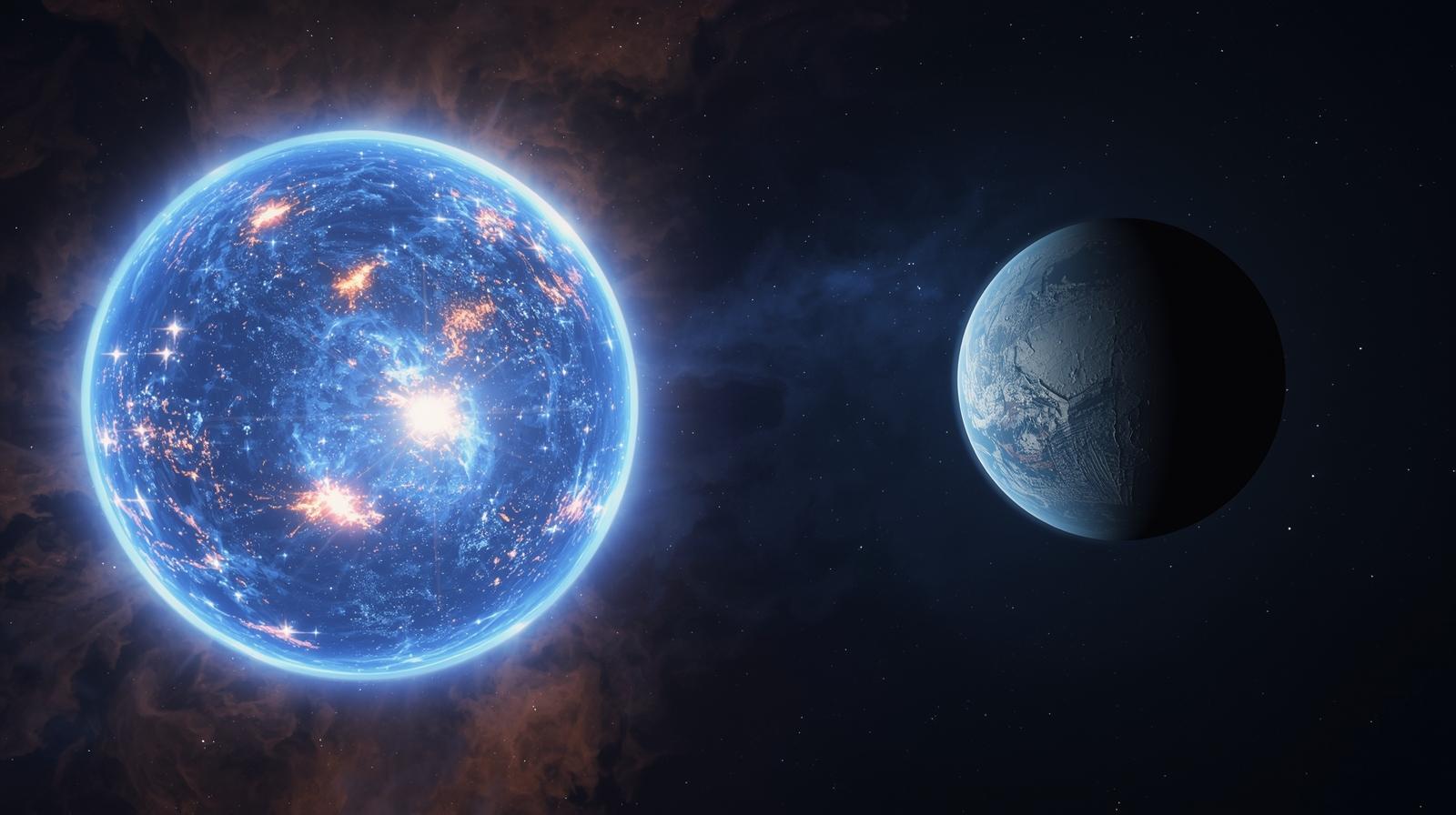What Makes Solar System vs Galaxy Different?
When I first looked up at the night sky as a child, I wondered whether those twinkling dots were planets or entire galaxies. Understanding the solar system vs galaxy debate transformed my perspective on our cosmic neighborhood. This comparison reveals fundamental truths about our universe’s structure and scale.
Our solar system includes the Sun, eight planets, five dwarf planets, and hundreds of moons, asteroids, and comets. Meanwhile, galaxies are massive cosmic structures containing billions of stars, each potentially hosting their own planetary systems.
The key distinction in the solar system vs galaxy comparison lies in scale and composition. A solar system represents a gravitationally bound collection of celestial bodies orbiting a single star, while a galaxy comprises billions of stars held together by gravitational forces across vast distances.
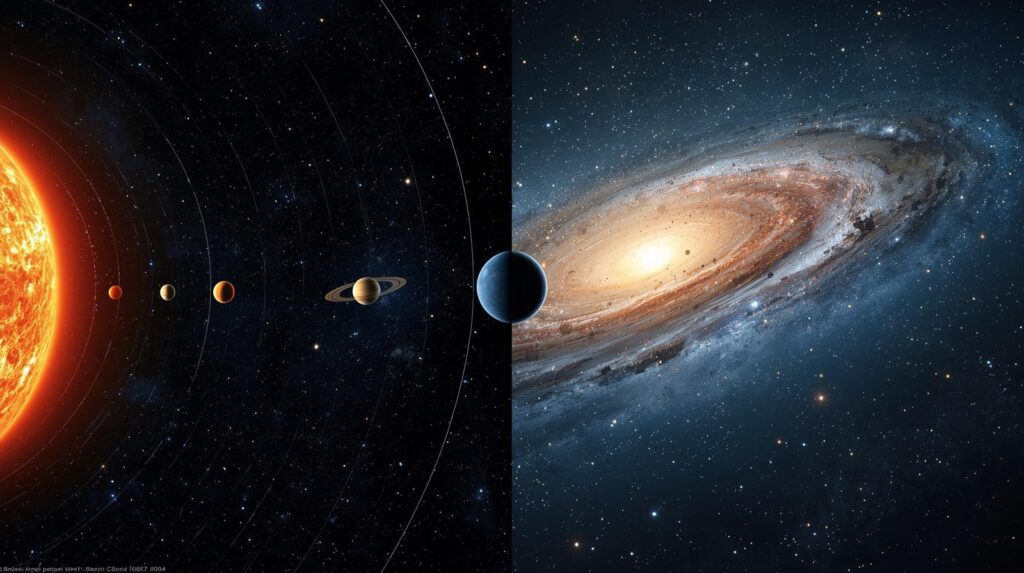

Understanding Our Solar System’s True Scale
The solar system or galaxy question often confuses people because of the immense distances involved. A journey at light-speed to the outer edge of our solar system’s Oort Cloud would take approximately 1.87 years, demonstrating that even our local cosmic neighborhood spans enormous distances.
When examining the solar system and galaxy relationship, consider this: our solar system extends over 3 light years across when including the Oort Cloud’s outermost boundaries. This measurement helps illustrate the solar system’s impressive size, though it remains minuscule compared to galactic dimensions.
Our solar system formed approximately 4.6 billion years ago from a collapsing molecular cloud. The Sun contains 99.86% of the system’s total mass, with Jupiter accounting for most of the remaining matter. This centralized mass distribution characterizes solar systems everywhere.
For more comprehensive information about cosmic structures, visit alldandy for detailed explanations.
Galaxy Dimensions That Dwarf Solar Systems
The solar system vs galaxy size comparison reveals staggering differences. The Milky Way galaxy spans 100,000 light years in diameter and contains an estimated 200 billion to 400 billion stars, making it incomprehensibly larger than any single solar system.
To truly grasp this comparison, consider that the Andromeda galaxy measures approximately 220,000 light-years wide, while IC 1101 galaxy spans as much as 4 million light-years. These measurements dwarf our solar system’s dimensions by factors of millions.
Galaxies come in several types: spiral galaxies like our Milky Way, elliptical galaxies containing older stars, and irregular galaxies with chaotic structures. Each galaxy type hosts countless solar systems, planetary nebulae, and interstellar clouds.
The observable universe contains between 200 billion and 2 trillion galaxies, with each potentially harboring billions of solar systems. This statistic emphasizes how the solar system vs galaxy debate represents comparing a single grain of sand to an entire beach.
Structural Components: Solar System vs Galaxy
| Feature | Solar System | Galaxy |
|---|---|---|
| Central Body | Single star (Sun) | Supermassive black hole + billions of stars |
| Size | ~1.87 light years (Oort Cloud) | 100,000+ light years |
| Number of Stars | 1,100 billion – 400 billion | Billions |
| Formation Age | 4.6 billion years | 13+ billion years |
| Gravitational Structure | Single star dominance | Complex multi-stellar dynamics |
This table clarifies the fundamental differences when discussing solar system vs galaxy characteristics. The structural complexity increases exponentially when moving from solar systems to galactic scales.
Solar systems orbit within their host galaxy’s gravitational field. Our solar system travels around the Milky Way’s center at approximately 828,000 kilometers per hour, completing one galactic orbit every 230 million years a period called a cosmic year.
How Many Solar Systems Exist in Galaxies?
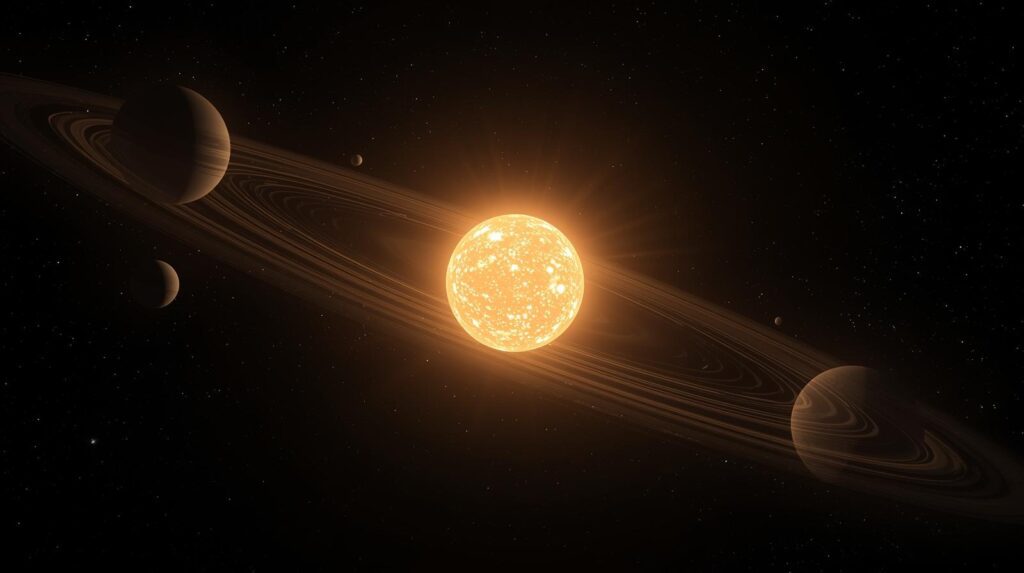

Understanding the solar system and galaxy relationship requires recognizing that galaxies serve as cosmic cities housing billions of solar systems. With the Milky Way hosting 200 billion to 400 billion stars, and many stars having planetary systems, our galaxy likely contains hundreds of billions of solar systems.
Recent astronomical surveys suggest that nearly every star possesses at least one planet. This discovery revolutionizes our understanding of the solar system vs galaxy framework, revealing that planetary systems represent the norm rather than the exception throughout the universe.
Different stellar environments within galaxies create diverse solar system types. Stars in dense galactic cores experience more gravitational interactions, while those in spiral arms like our Sun’s location enjoy relative stability for planetary development.
The galactic habitable zone concept suggests certain regions within galaxies favor life-supporting solar systems. Our solar system occupies an advantageous position neither too close to the chaotic galactic center nor too far in the resource-poor outer regions.
Personal Perspective on Cosmic Scale
After years studying astronomy, the solar system vs galaxy comparison never fails to humble me. Standing beneath a clear night sky, knowing that every visible star represents a potential solar system, and that hundreds of billions more exist beyond our sight within our galaxy alone, transforms stargazing into a profound experience.
I remember visiting a dark sky preserve where the Milky Way appeared as a luminous river across the heavens. Understanding that our tiny solar system occupies just one infinitesimal point within that band of light and that each point of light contains countless other solar systems fundamentally changed how I perceive humanity’s place in the cosmos.
Observable Universe and Beyond
The solar system or galaxy distinction becomes even more fascinating when considering cosmic hierarchy. Solar systems orbit within galaxies, which themselves cluster into galaxy groups, which form superclusters, which organize along cosmic filaments creating the universe’s large-scale structure.
Our Local Group contains over 50 galaxies, including the Milky Way, Andromeda, and Triangulum galaxies. Each member galaxy hosts billions of solar systems, collectively representing an incomprehensible number of worlds and potential habitats.
Proxima Centauri, our nearest neighboring star system, lies 4.25 light-years away, demonstrating that even traveling between nearby solar systems within our galaxy remains beyond current technological capabilities.
Navigating the Cosmic Address System
The solar system and galaxy hierarchy provides our cosmic address. We reside on Earth, the third planet from the Sun, within the solar system, positioned in the Orion Arm of the Milky Way galaxy, which belongs to the Local Group, located within the Virgo Supercluster, situated in the Laniakea Supercluster of the observable universe.
This address system illustrates how solar systems represent the fundamental building blocks of galactic structure. Without solar systems, galaxies would contain only free-floating stars, planets, and interstellar material without the organized planetary architecture that enables complex chemistry and potentially life.
Understanding the solar system vs galaxy relationship helps astronomers search for exoplanets, predict stellar evolution, and map cosmic structures. Modern telescopes can now detect individual solar systems in nearby galaxies, revealing planetary diversity across the universe.
Scientific Research and Future Discoveries
According to data from NASA, ongoing research continues revealing new insights about both solar systems and galaxies. Space telescopes like James Webb are detecting exoplanets in distant solar systems, while ground-based observatories map galactic structures across billions of light-years.
The solar system vs galaxy comparison evolves as technology advances. Recent discoveries include solar systems with planets orbiting binary stars, galaxies colliding and merging, and supermassive black holes governing galactic centers.
Future missions aim to photograph Earth-like planets in other solar systems directly, measure dark matter distribution in galaxies more precisely, and potentially detect biosignatures in exoplanet atmospheres. Each discovery refines our understanding of cosmic structures and our place within them.
Why This Comparison Matters for Everyone
Whether you’re a student, educator, space enthusiast, or simply curious about the universe, understanding solar system vs galaxy differences provides essential cosmic literacy. This knowledge helps contextualize scientific discoveries, appreciate astronomical photography, and grasp humanity’s cosmic perspective.
The scale differences between solar systems and galaxies challenge human intuition. We evolved understanding distances measured in steps and miles, not light-years and galactic diameters. Grasping these concepts requires intellectual flexibility and imaginative thinking.
Educational initiatives worldwide now emphasize the solar system and galaxy relationship to inspire scientific curiosity in younger generations. Planetariums, observatories, and science museums create immersive experiences helping visitors comprehend cosmic scales through visualization and interactive exhibits.
Frequently Asked Questions
Q1: How many Earths could fit inside the Milky Way galaxy?
The volume comparison between Earth and our galaxy defies easy comprehension. Considering the Milky Way’s 100,000 light-year diameter versus Earth’s 12,756-kilometer diameter, roughly 3.6×10^13 Earths could fit across the galaxy’s diameter alone. The volumetric difference exceeds human intuition by countless orders of magnitude, illustrating why the solar system vs galaxy comparison reveals such dramatic scale differences.
Q2: Can solar systems exist outside galaxies?
Yes, rogue solar systems occasionally get ejected from their host galaxies through gravitational interactions during galactic mergers or close encounters with massive objects. These intergalactic solar systems drift through the void between galaxies, representing cosmic nomads separated from the galactic communities where they formed. However, the vast majority of solar systems remain gravitationally bound within their parent galaxies throughout their existence.
Q3: Will our solar system survive when Andromeda and the Milky Way collide?
When our galaxy merges with Andromeda in approximately 4.5 billion years, our solar system will likely survive intact despite the dramatic galactic collision. The immense distances between stars mean actual stellar collisions remain extremely rare even during galactic mergers. However, our solar system’s galactic orbit will change dramatically, potentially relocating us to different regions of the merged galaxy dubbed “Milkdromeda.” Understanding the solar system vs galaxy relationship helps astronomers predict such cosmic events.
Q4: What determines whether a star can host a solar system?
Multiple factors influence planetary system formation, including the star’s mass, metallicity (elements heavier than hydrogen and helium), age, and location within its galaxy. Stars in metal-rich environments form more robust planetary systems because these elements comprise the raw materials for planet construction. Our Sun’s favorable metallicity and stable galactic orbit contributed to our solar system’s successful formation and long-term stability within our galaxy.
Q5: Are galaxies like cities and solar systems like houses?
This analogy effectively communicates the solar system and galaxy relationship! Galaxies resemble cosmic cities containing billions of stellar “residences” (solar systems), interconnected by gravitational “roads” (orbital paths), with a “downtown” galactic center, suburban spiral arms, and rural outer regions. Each solar system houses its own family of planets, moons, and smaller bodies, just as individual houses contain their residents. This metaphor helps people understand cosmic organization without getting lost in overwhelming numbers.
Now that you understand the profound differences between solar systems and galaxies, how has your perception of humanity’s place in the universe changed?






